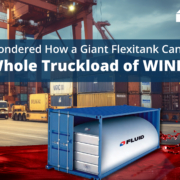Leading Flexitank Manufacturer in India for Bulk Liquid Transportation
Fluid Flexitanks, a leading Flexitank manufacturer in India, is revolutionizing the world of bulk liquid transportation with high-quality, innovative flexitanks designed to streamline your shipping process and maximize cost-effectiveness.
This blog dives into the world of Fluid Flexitanks, exploring their specifications and numerous advantages for your business.
Fluid Flexitanks: Engineered for Strength and Efficiency
Fluid Flexitanks, meticulously crafted by a leading Flexitank manufacturer in India, are built for strength and reliability during transport. Here’s a closer look at their key components:
-
Multi-Layered Construction: Made by a leading Flexitank manufacturer in India, Fluid Flexitanks boast a robust, multi-layered design. Food-grade polyethylene inner layers ensure product purity and compatibility with various non-hazardous liquids. Additional woven polypropylene layers provide structural integrity and puncture resistance.
-
Capacity and Dimensions: Designed to fit snugly within standard 20-foot shipping containers, Fluid Flexitanks (manufactured by a leading Flexitank manufacturer in India) offer capacities ranging from 14,000 litres to a maximum of 24,000 litres, maximizing payload per container.
-
Discharge and Filling Systems: Secure discharge and filling valves, strategically positioned for efficient product transfer and minimal spillage risks, come standard with every Fluid Flexitank.
-
Safety Features: As a leading Flexitank manufacturer in India, safety is paramount at Fluid Flexitanks. Our flexitanks undergo rigorous testing to comply with international shipping regulations. Tamper-evident seals and high burst strength ensure the secure and compliant transportation of your liquids.
-
Customization Options: We understand your needs might be unique. As a leading Flexitank manufacturer in India, We offer customization to cater to your specific cargo requirements. This may include:
- Material Selection: For specific liquids requiring enhanced chemical resistance, we can provide flexitanks with customized inner liner materials.
- Discharge Options: Depending on your unloading facilities, we offer top or bottom discharge configurations.
- Temperature Resistance: Need to transport liquids at elevated temperatures? We’ve got you covered with flexitanks designed for high heat.
Advantages of Fluid Flexitanks: A Winning Formula for Businesses
Fluid Flexitanks, manufactured by a leading Flexitank manufacturer in India, offer a multitude of advantages over traditional bulk liquid transportation methods like drums, IBCs, and tank containers. Here’s how they can benefit your business:
-
Cost Savings: Our flexitanks are significantly more cost-effective. Their larger capacity per container reduces the number of containers required, lowering overall shipping costs. Additionally, their single-use nature eliminates return freight charges associated with reusable containers.
-
Increased Efficiency: Fluid Flexitanks, manufactured by a leading Flexitank manufacturer in India, are quicker to load and unload compared to other methods. Their collapsible design allows for easier storage when empty, freeing up valuable warehouse space.
-
Reduced Risk of Contamination: Since flexitanks are single-use, the risk of contamination between shipments is minimized. This is particularly advantageous for transporting food-grade liquids and other sensitive products.
-
Environmental Benefits: Our Flexitanks are generally recyclable, making them an eco-friendly choice. Additionally, their efficient use of space within containers reduces overall carbon footprint during transportation.
-
Versatility: Fluid Flexitanks, manufactured by a leading Flexitank manufacturer in India, can accommodate a wide range of non-hazardous liquids, making them a highly versatile solution for various industries.
Why Choose Fluid Flexitanks, a Leading Flexitank Manufacturer in India?
At Fluid Flexitanks, a leading Flexitank manufacturer in India, we are committed to providing exceptional customer service and top-quality products. We offer:
-
Rigorous Quality Control: Our flexitanks undergo stringent quality checks throughout the manufacturing process, ensuring they meet the highest standards of durability and safety.
-
Global Network: We have a well-established network of partners across the globe, ensuring you receive the support and expertise you need wherever you are located.
-
Technical Expertise: Our team of specialists at Fluid Flexitanks, a leading Flexitank manufacturer in India, possesses in-depth knowledge of flexitank technology and bulk liquid transportation regulations. We are happy to answer your questions and guide you in selecting the most suitable flexitank for your specific needs.
By opting for Fluid Flexitanks, a leading Flexitank manufacturer in India, you gain a reliable partner dedicated to optimizing your bulk liquid transportation process. Contact us today to discuss your requirements and experience the Fluid Flexitank difference!










